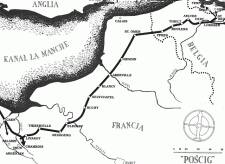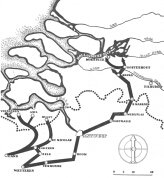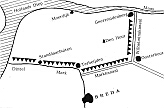NORMANDY
On August, 8th 1944, after a four year's interval, the Mounted Rifles again entered into action. Remembering the defeats of autumn 1939 and spring 1940 they once more commenced their fight for revenge and Poland's freedom, knowing that, faithful to the traditions of the Regiment, they would fulfil the task assigned to them, adding honour to their colours and having in their hearts the feeling of duty well done.
They had the prospect of gruelling fighting as fiendish as modern equipment could make it and the enemy fought back stubbornly. They were the picked units of the German army. The Division took part in the break-through at Caen, our Regiment acting as the reconnaissance unit.

click on map to enlarge
Until the 15th of August the Regiment fought its first real battle, southeast of Caen, gaining experience in action and proving the deadliness of "Tigers" and "Panthers". They were under artillery fire, they met the danger of the "Panzerfaust" and also were bombed from the air. The men were used to their weapons and trusted them and so the Cromwells became an integral part of the Monted Rifles. The tanks gave the men both power to fight and shelter from the battle, for at night they slept in dug-outs under them and gave, in exchange, appreciative care to their vehicles.
On August the 15th, "Soldiers Day", the Regiment was assigned to Reconnoitre in the locality of Jort and capture the river crossing. They succeeded in breaking the resistance of the enemy in a strong attack on the hills near Jort. After a ten hours' fight, repelling counter-attacks from "Tigers", they reached the river, crossed it and surrounded the locality. The last line of enemy resistance was broken. On the following day the CO of the Division, General Maczek, addressed us in these words: "You have fought a magnificent battle and to not even realise how much you have done."
Then followed battles to close the Falaise gap. The Regiment preceding the Division, moved towards Trun and Chambois, cutting off the retreating enemy convoys and trying to contact the
Americans, who were the second side of the closing pincers. The Regiment followed the retreating Germans, witnessing the tragedy of a defeated army.
On the 19th of August, on the outskirts of Chambois, the last possibility of retreat was cut off. The Dragoons took Chambois and combined with the Americans. The trap was closing in but the lines of our troops were considerably thinned, and the Germans had not lost hope of breaking through the circle.
This battle was the fiercest in Normandy. During the night of the 19th to 20th of August and on the following day the Regiment, cut off from the rest of the Division, continually repelled enemy attacks. All around the ground was littered with wounded and dead Germans, burning tanks and armoured cars. The number of prisoners rose steadily. The commander of a German Army Corps, with practically his entire staff, were made prisoners. On that morning the Regiment lost its CO, killed by a rifle shot. On the same evening the Regiment repelled the last enemy attacks and came into contact with the American Infantry. They were at the end of their ammunition and fuel, but received fresh supplies by air.
On the following day, Major Maciejowski was buried and Lt. Col. Skibinski again appointed CO of the Regiment.
The Falaise battle was won and the Regiment moved with the entire Division to the Barou region for a few days' rest. During the stay near Barou the Regiment was entirely reconditioned with men and equipment and prepared for further action.
ACROSS FRANCE
On the 25th of August Lt. Col. Skibinski departed to be appointed CO of the 3rd Infantry Brigade and the command of the Regiment was taken over by Captain George Wasilewski, formerly 1st Squadron's commander.

click on map to enlarge
At the end of August the Division advanced rapidly towards Rouen, crossed the Seine on a bridge built by Polish engineers and overtook the Canadian infantry pursuing the enemy who had been defeated in Normandy.
September 1st 1944 was the 5th anniversary of the German invasion of Poland and the Regiment started its victorious advance. Then followed a period of rapid blows, of unexpected clashes and of risky decisions. Success depended on speed of action. The indomitable Cromwells covered great distances, at top speed. Preceding the Division; the Regiment, sometimes out of wireless range, reconnoitred, captured river crossings, fought fiercely and still drove onwards. Numbers of prisoners and a great amount of booty were taken.
During the first day of pursuit the Regiment covered 95 km and reached Abbeville, fighting all the way against the enemy who were trying to cause delay. On the following days the Regiment moved North-East past Boisle - Hesdin - Wittes - St.Omer Canal -
BELGIUM
- the Belgian frontier - Ypres - Roulers - Hooglede and Gits to Thielt. They stopped on September, 8th, for a few days' rest.

click on map to enlarge
HOLLAND
On September, 16th, the Regiment attached to the group of the 3rd Infantry Brigade, entered into action by the Hulst Canal - Axel and in the German defence of the port of Antwerp on the Southern estuary of the Schelde where Allied ships were prevented from approaching.
In the low, flat and damp Dutch country, cut by canals, the Germans had flooded all the areas which were under sea level and only roads and dikes were of any use to the advancing forces. The enemy' s resistance toughened, and after expending great effort with a consequent loss of time, they forced the Hulst Canal but were eventually forced back in the sea. On September 26th the Cromwells reached the coast and sank with gunfire several large German armed barges, loaded with troops.
Special mention in our history must be made to the capture of a German patrol-boat. It was a small craft armed with a depth-charger thrower, 2 guns and a few machine guns. After having been repaired by our unit she was equipped with a crew of Mounted Rifles and piloted by a friendly and helpful Dutch sailor, she resisted the attacks of similar enemy craft, and went under Polish
flag to reconnoitre on the other side of the estuary. She underwent heavy damage in the form of 3 hits from a German coastal battery, but could be repaired a second time and was taken to Terneuzen, escorted by our Infantry.

click on map to enlarge
After having completed this operation. The Regiment moved on to Kemseke to rest, receive supplies and be reorganised. The Anti-Aircraft troop was omitted and there was one combat troop less in each of the three squadrons. This was the result of lack of trained crews and difficulty in obtaining equipment. The reconnaissance troop received no replacements for its losses and remained smaller than before.
A new small unit was created, the Rifles Platoon, with 25 men in four armoured, half-tracked vehicles. The HQ squadron was split in two, the special squadron and the HQ squadron which were composed as follows:
Special Squadron:
- Commander's troop
- Reconnaissance troop
- Rifles platoon
- Liaison platoon
- Sanitary platoon
- Technical platoon HQ Squadron
- Quartermaster's detachment.
On September 27 the Regiment advanced rapidly East of Antwerp, where the Division reassembled before the next fight which was to take place in Southern Holland. The target was Tilburg.
On September 28 the Regiment crossed the Albert Canal and from a bridgehead established by the British, they went out reconnoitring towards Merxplas. Alone they could not break through the solid enemy defence surrounding the bridgehead and it was only with the help of larger units from the Division that they were able to make a slight progress.
After that the advance was slow but steady. The enemy's aim was to slow us at all costs and they had heavy losses, although the low and wet land hindered our advance and helped them. The Regiment's main assignment was to support the Infantry Brigade and it attacked independently several times around Merxplas from the East and drove through the forests North of Merxplas, taking the river crossing near Zondereigen, then attacked the enemy in the near from the West between Zondereigen and the Dutch frontier.
Another blow on the Eastern side cut the road between Turnhout and Baarle-Nassau. This last region was then outflanked from the West. The Regiment appeared from the West in the rear of the enemy, who were defending the forests North of Baarle-Nassau. They defended the town against the enemy counter-attack from the East and drove on to Baarle-Boschoven and Alphen-Boschoven.
The advance was slow and the distances covered daily were small. The enemy had at its disposal a large number of artillery and anti-tank guns, but in spite of this fact the Regiment was successful, due mainly to the decision to act in force in one direction with the whole strength behind the thrust.
Driving a deep wedge into the enemy lines, the Division reached Baarle-Nassau and was separated from the rest of its Army Corps. Most of the latter's troops were in other sectors and could not support the Division action. On October 5 the order came to remain in defence of the captured territory.
The Regiment stood in readiness along the railroad, our neighbours in the right were our own infantry and on the left the English infantry. The enemy was standing beyond the railroad. The ranks of our troops were thin but the Regiment stood in compact grouping, keeping guard along the line of tanks. The soldiers lived in dugouts under their tanks, sheltering from heavy artillery fire.
During a fortnight's stay the Regiment was reequipped and the crews received further training. Several attacks were made and we were then recalled to the rear.
On October 26 an important offensive developed with a view to taking the rest of Southern Holland and reaching the Maas. The Division moved towards Gilze, Breda and Moerdijk. On the first day of the offensive the Regiment attacked from the right flank, advancing far beyond the Division. They took Gilze, cut off the Tilburg-Breda road and went out to reconnoitre towards the Wilhelmina-Canal.
On the following day, attacking to the West they took Bavel and reached the outskirts of Breda. On October 30 the Regiment passed through Breda which had been captured by the 3rd Infantry Brigade, and reached the Mark river, lying to the North-East of Breda. The bridges over the river were destroyed and a fight had to be made for the crossing. For a few hours the Regiment with the Rifles Platoon, a few tank crews and one 9th Bataillon Platoon held a small bridgehead, but a withdrawal was made due to enemy tanks and infantry counter-attack.
After several days of heavy fighting along the river and Mark canal the 10th Armoured Cavalry Brigade finally forced the canal on the right flank and enlarged the bridgehead.
On November 4 the Regiment left the bridgehead and reconnoitred in Made and Wagenberg where it met with strong resistance and suffered heavy casualties. The enemy were strong and well-armoured and as the soil as far as the Maas is shallow and damp, tanks could only advance on the roads, and even there several were bogged.

click on map to enlarge Mark-Dintel Line
The fighting of the following days cleared the whole of the Southern Netherlands with the exception of Moerdijk which was a strongly fortified German bridgehead, defended by infantry and self-propelled guns and supported by a powerful artillery from the other side of the Maas. The
country is flat, quite open and very damp and the roads leading to the bridgehead were barricaded by road blocks of reinforced concrete. The men could not stand under the constant artillery fire and a small hole dug in the ground was immediately filled with water. Our infantry had to withdraw beyond the reach of artillery fire after several days' trial.
Our Regiment tackled the task assigned to them in this way: During two days, the 7th and 8th of November they fought a passage into the bridgehead attacking with all three squadrons on three different roads. They destroyed three self-propelled guns, silenced other guns and some infantry and approached the road blocks. The tanks set out one at a time and firing their armour-piercing ammunition they smashed the concrete. Under continual enemy fire they evacuated their wounded comrades and the tanks which were damaged and went out on pounding at the walls.
After two days the bridgehead was won. 2500 armoured piercing projectiles and high-explosive shells achieved this results. The passage was open and the 24th Lancers Regiment arrived with fresh ammunition and in a magnificent attack took Moerdijk and broke the last of enemy resistance. The bridgehead was wiped out and the aim of our offensive was completed. A month on the Maas lay ahead of us.
|